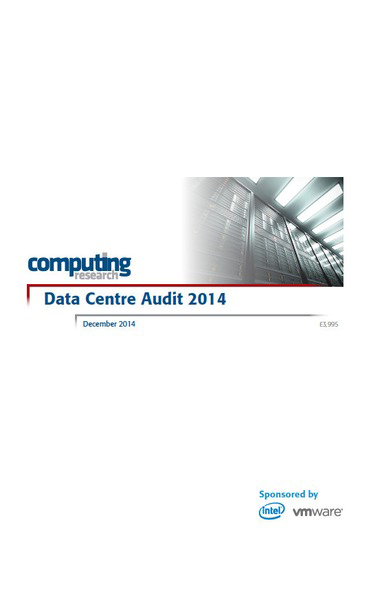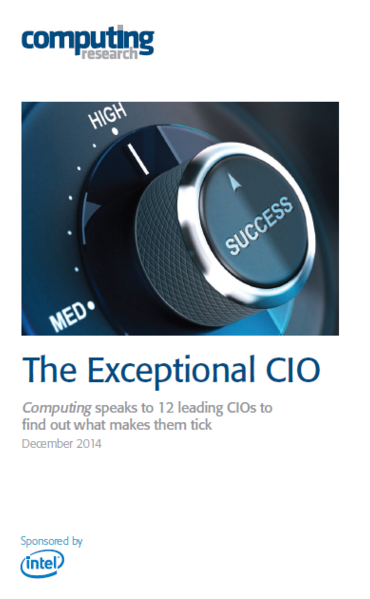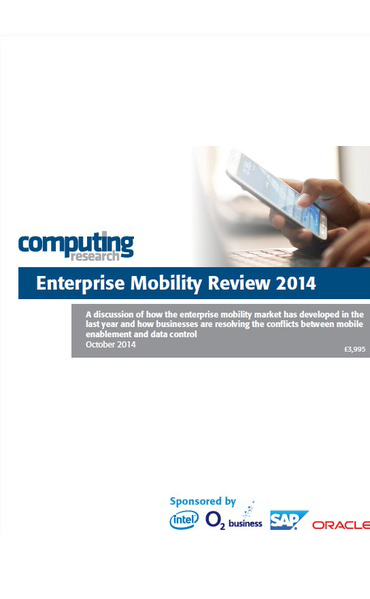
Computing's primary research is conducted amongst its own audience of senior IT professionals. We use a rigorous research methodology, encompassing individual depth interviews (IDIs), focus groups, and major quantitative studies: these are not 'surveys' - we test our findings with leading CIOs and industry practitioners and we are totally independent.
Our aim is to establish clear truths of how IT is changing, what is driving that change and who is making the critical decisions, so we can provide our audience with a baseline of knowledge that penetrates past vendor hype and pundit prediction.
Computing Research forms the bedrock of our conference programme: funded by our event partners, Computing Research provides analyst grade data free of charge to registered users.
Computing Enterprise Security Review 2017 - published November 2017
If 2016 was the year that turned many aspects of conventional wisdom into history, 2017 was the year in which the drawbacks of the digital revolution have become abundantly and brutally clear. This revolution has changed the nature of everything - including warfare and crime. In a world with no borders, where none of the old rules apply, we find that traditional approaches to data security are no longer proving effective. We appear to be losing one battle after another. The Computing Enterprise Security Review 2017 discusses the impact of mainstream media news about cyber-attacks on attitudes to data security and the role of ransomware in particular in shaping attitudes. It also looks at strength-in-depth solutions and technologies such as blockchain which could be valuable, potentially, in ascertaining authenticity.
Cloud & Infrastructure Review 2017 - published September 2017
The review discusses how data centre strategies are evolving and the degree to which the cloud is informing those strategies. The level of understanding of the different cloud models is discussed before we look at their respective adoption levels. In particular, the impact of serverless computing and its implications for other technologies within the data centre is covered at length. The review then moves to the market place for cloud services and the implications of the skills shortages being experienced by many organisations on the growth of cloud services. It concludes with a discussion about the future of the cloud - and the role of AI in particular. Along with our quantitative research, the review contains some unique insights from high-ranking IT decision makers into how and why cloud services are being adopted and what this means for the traditional data centre.
Big Data & IoT Review 2017 - published May 2017
For several years now, big data technologies have enabled the acquisition and analysis of data that had formerly been out of reach. The development paths of technologies such as real-time analytics and machine learning are beginning to converge, and understanding of them and the possibilities they present is increasing. For the fifth year running, Computing has conducted comprehensive research on the subject of big data. For the first time this year, we have chosen to combine our research on big data technologies and IoT due to the interdependent nature of these two areas. The review contains some unique insights from high-ranking IT decision makers into how important they believe IoT is for their organisations and how they are preparing for IoT and initiating projects. We discuss the challenges IoT poses in terms of the veracity of data, how close we are to genuine data-driven decision making and the technologies that businesses are building their strategies on as well as the degree to which the cloud features in strategy. The review concludes with a discussion of what constitutes a leader in big data/IoT and how this relates to the wider picture.
DevOps Review 2017 - published March 2017
The Computing DevOps Review 2017 summarises the results of a comprehensive research program undertaken by Computing during the first quarter of 2017. The review begins with a look at the patterns of growth in DevOps and a detailed discussion about the expectations of DevOps held by different individuals throughout organisations. The discussion then moves onto where delays are occurring in the Software Development Life Cycle (SDLC) and how the imperatives of speed, quality and security are being balanced. The role of automation in every aspect of the SDLC is considered, in particular whether automation can facilitate the integration of security into the earliest stages of the cycle. The final third of the review focuses on technology and tools. We cover how organisations are making those choices and the roles, merits and possibilities of technology such as Infrastructure-as-Code (IaC), microservices, containerisation and serverless cloud.
Enterprise Security Review 2016 - published September 2016
The Computing Enterprise Security Review 2016 discusses how the size of an organisation affects the approach it takes to security, the implications of differing priorities among different teams and whether smaller organisations are at greater risk of attack. The discussion covers spending patterns, the ransomware threat, views on the impending EU GDPR - and whether Brexit is likely to make a material difference to organisations' approach to data protection. The Review considers the question of whether the steady stream of stories in the media about successful hacks is helping or hindering security professionals - and whether the cumulative effect is to increase spending on preventative measures. The discussion concludes with an analysis of real-time cyber security and whether it represents our only chance of winning the security arms race.
Cloud & Infrastructure Review 2016 - published September 2016
This is the fourth annual review published by Computing on the subject of infrastructure and data centres, but the first to be a cloud focussed publication. Cloud has finally made the jump to the mainstream rather than being utilised highly selectively by a majority of organisations for non-critical workloads and storage. 77 per cent of those surveyed were using cloud services to some extent. A further ten per cent were trialling them. Three quarters of survey respondents also expected their use of cloud services to increase in the next year. The issue now is how to integrate it with the rest of the infrastructure.
DevOps Review 2016 - published July 2016
As business organisations execute their digital strategies and the expectations of consumers and business partners continue their relentless upward trajectory, DevOps constitutes a key way for organisations to meet and even anticipate expectations, along with closely related technologies and methodologies such as continuous integration and agile. The 2016 review begins with an analysis of the key changes that have taken placeand a discussion of how organisations are measuring their DevOps success and increasing the likelihood of it. We also look at some of the factors driving growth as well as those impeding it. The challenge of building the right team is also explored, as are the tools and methodologies used to make DevOps work.
Internet of Things Review 2016 - published May 2016
For some time now pundits have been predicting great things for the Internet of Things (IoT), from smart cities and smart homes to smart energy grids, driverless cars and autonomous robot helpers. Certainly the number of "things" is rising fast; according to one leading analyst, 6.4 billion connected things will be in use by the end of this year - an increase of 30 per cent from last year, meaning five million new things are now connecting up every day. What does this actually mean for organisations and individuals? The Computing Internet of Things Review 2016 contains some unique insights from high-ranking IT decision makers into just how much impact IoT is having on specific industries and individual organisations, and discusses at length the opportunities that IoT can confer on both the enterprise and the individual.
Big Data & Analytics Review 2016 - published March 2016
Like material wealth, the ability to use data for analytics accrues to itself. Our latest research review looks at the gap between the big data 'haves' and 'have-nots' and investigates the shared characteristics of those organisations that are succeeding with big data, in terms of structure attitude, skillsets, sector and outlook. Subtitled 'Learning from the leaders', the Computing Big Data and Analytics Review 2016 also considers the role of the data scientist and how that role is evolving to fill the yawning gulf in skills, and surveys the tools used in analytics including Apache Hadoop and Spark.
Data Security & Risk Management Review 2015 - published November 2015
As corporate data has become more mobile and more distributed it has also become significantly more difficult to secure. This difficulty has led to some incredibly high-profile raids on corporate data and the profile of data security rising to a new level among company executives and consumers alike. The Computing Data Security and Risk Management Review 2015 discusses how data security is now at the very top of the corporate agenda and why it arrived there as well as where the responsibility for security should reside. We also discuss how organisations are reaching and maintaining a balance between greater security and the flexibility necessary to retain employees, avoid the use of insecure workarounds and meet business objectives. The types of threats are discussed, as is the attitude towards outsourcing aspects of data security. The review concludes with a detailed discussion of the information security gap - what it is, why it exists and how businesses are attempting to bridge it.
Data Centre Audit 2015 - published September 2015
Cloud services, and to a lesser extent co-location, are heading rapidly towards mainstream adoption, which is having a considerable effect on the in-house data centre. The Computing Data Centre Audit 2015 summarises the results of a comprehensive research programme undertaken during the third quarter of 2015. In it we look at the impact of cloud and colo and find that while some organisations are consolidating or reducing capacity, the majority expect spending to increase, although new skills will be required as the data centre becomes an element of a larger whole rather than the centre of operations.
DevOps Review 2015 - published August 2015
The separation of development and operations in business organisations makes so little sense that one is led to wonder how it ever came about. This separation hinders communication, fosters resentment and undermines trust - all of which results in a slower software delivery across the business. The Computing DevOps Review 2015 summarises the results of a comprehensive research programme undertaken during the second quarter of 2015. It begins with a discussion of the definitions and perceptions of DevOps and the factors leading businesses to consider it. It examines the benefits of DevOps and fundamentals of a successful approach along with the difficulties faced by businesses when trying to reshape their organisations. The review concludes with a discussion of what DevOps actually looks like in reality for the organisations who are making these changes.
Enterprise Mobility Review 2015 - published July 2015
The drive for ever greater levels of mobility within UK enterprises is showing no signs of abating. Indeed, 2015 has seen a maturing of enterprise mobility as a greater number of businesses move past the introductory phases of mobility such as developing policies on BYOD and making decisions about platforms. As strategies mature, organisations are grappling with the nuts and bolts of integrating mobile applications with other infrastructure and building a mobile architecture that is secure and yet sufficiently agile to deal with the changing face of mobility in the years ahead. The Computing Enterprise Mobility Review 2015 looks in depth at the benefits that organisations are achieving - or hope to achieve - from increased mobility, with a focus on apps and platforms.
Big Data Review 2015 - published May 2015
Big Data hype has now been firmly replaced by real case studies and usage of advanced analytics, agile storage and data centralisation. In particular, more developed real-time analytics are pushing increasing numbers of organisations to take the Big Data plunge, driven by both the prospect of speedy gains from internal efficiencies and a longer term prospect of speculative analysis of external data to potentially open up new markets and opportunities. The pace of democratisation of data analytics is increasing, with huge implications for businesses. When decision-making is truly data-driven and access to analytics is not restricted to a few personnel, everything can happen faster, making businesses more agile and efficient. Greater empowerment for a greater number of employees could be a very positive thing and potentially lead to changes in the traditional corporate hierarchies with which we are all so familiar.
Data Centre Audit 2014 - published Jan 2015

The pressure on the data centre has never been greater. Exponentially increasing quantities of data need to be analysed in real time and secured from those who might have ill intent. Data also has to be stored, managed and secured in a way that satisfies industry and government regulators. The Computing Data Centre Audit 2014 summarises the results of a comprehensive research programme undertaken by Computing during the third quarter of 2014. The review contains some unique insights from highranking IT decision makers into how the data centre is coping with the escalating demands placed upon it.
The Exceptional CIO - Interviews with 12 leading CIOs - published Dec 2014

Computing Research recently undertook a major research project with one clear objective: to provide a better understanding of the decision-making process for large-scale IT procurement in the UK. Of particular interest to us was the role of different IT and business decision-makers at each stage of the procurement process.
Data Security and Risk Management Review 2014 - published Oct 2014
The interwoven mega-trends of the cloud, social media, big data and the rise of the smartphone and tablet have worked together to render traditional network perimeter security models ineffective. The Data Security and Risk Management Review 2014 establishes how business organisations are adapting their security strategies, taking a more targeted approach informed by maturing risk assessment processes. It looks at the trade-offs between security and performance, the changing areas of vulnerability and of the threats themselves. It investigates the most popular solutions and includes an analysis of the security partners that businesses are choosing.
Computing Enterprise Mobility Review 2014 - published Sept 2014

Enterprise mobility is at once presenting business organisations with huge potential gains and also huge challenges. This review looks at the difficulties facing organisations as they navigate the relationship between the enablement of users and the need for data control, and discusses the policies that they are putting in place to achieve both objectives.
Computing Big Data Review 2014 - published June 2014
The market for big data processing and analytics changed significantly over the 12 months prior to the publication of this report. Awareness of the benefits has increased alongside other factors such the maturity of cloud platforms and availability of open-source big data solutions. The Computing Big Data Review 2014 summarises the results of a comprehensive research programme with the findings compared with those published 12 months earlier to discover the direction of travel.
Computing Enterprise Mobility Review 2013 - published Sept 2013
The review contains some unique insights into the specific challenges companies face and the benefits they are reaping with enterprise mobility. It discusses how the enterprise mobility ecosystem has evolved, what it looks like today and where it may be headed. Key highlights from the research include: Attitudes to mobile working have evolved from "cautious" and "resistant to change" to "strategy driven" and "forward thinking"; Key drivers of mobility projects are efficiency, productivity and the simple desire not to be left behind as technology and expectations evolve; Organisations are tending to approach mobility projects from a viewpoint of security and control rather than enablement of the user.
Computing Big Data Review 2013 - published May 2013
The Big Data Review 2013 summarises the results of a comprehensive research programme undertaken during the first quarter of 2013. Highlights from the research include:
Big data projects are being driven largely by IT teams rather than the areas of the business standing to gain the most from them; A significant shortage of skills in big data analytics is hampering wider take up; Customer data is by far the fastest growing domain, and increasing numbers of organisations are describing their attitude to data management as "customer driven".
Computing IT Buyer's Review 2012 - published April 2012
Central to the success of IT sales and marketing is a need to build an intimate understanding of the target buyer: Who are they? How do they buy? What processes do they follow? What are their challenges, priorities and objectives? This review provides B2B technology sales and marketing professionals with a unique insight into how customers buy; the key drivers and influences behind IT purchasing; and the intricacies of the buying process itself. Of particular interest will be the roles of various IT and business decision-makers at each stage in the procurement process, the information and assurances they look for and the information sources they turn to.

